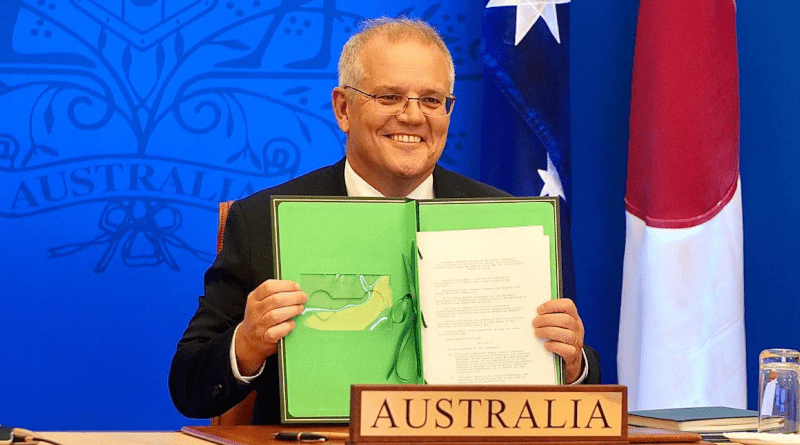Australia And Japan Confirm Their Mutual Defense Trajectory – Analysis
The Reciprocal Access Agreement is a symbolic breakout for both nations
Australian and Japan have signed a security treaty in a virtual ceremony to upgrade the two country’s defence and security cooperation. This is being portrayed by both Australia and Japan as a move to enhance ties amid China’s economic and military rise within the Pacific region.
The Reciprocal Access Agreement (RAA) sets out a framework for Australia and Japan defence forces to closely cooperate with each other to meet shared strategic security challenges and contribute to a stable Indo-Pacific region.
This agreement is intended to build upon strong existing bilateral and multi-lateral relationships, on top of the United States, Japan, India, and Australia alliance, known as the Quad.
Outside of the Japan-US bilateral military agreement, this is the first reciprocal military forces agreement, a breakout from the traditional position of the Japanese Self-Defence Forces (JSDF). Japanese military hardware and personnel will travel outside of Japan, and use Australia as a training location, while Australia now has a land base in proximity to the East China Sea, and Sea of Japan, near China and North Korea, also being accessible to Taiwan.
The Japanese Self-Defence Forces were formed in 1954, meeting with civic opposition at the time. Article 9 of the Japanese constitution forbids war as a sovereign right, or the use of force to resolve international disputes. Section 2 of Article 9 states that Japan is forbidden to have land, sea, or air forces that have potential war capability.
However, successive Japanese governments over the years have reinterpreted Article 9. The JSDF initially only defended Japan’s coastal areas, leaving strategic defence to the United States, stationed on Japanese territories. The doctrine of Japan being an ‘unsinkable aircraft carrier’ was abandoned in 2007, when Japanese forces cooperated with US forces and other forces in overseas theatres of war. In 2018, Japanese forces conducted multi-lateral exercises on the Sea of Japan with the Britain, Canada and the US.
The JSDF has 240,000 active personnel, where 1.0 percent of GDP goes towards defence. Japanese forces are regarded as the best equipped military in the region. THE JSDF has a mixed array of imported and domestically produced equipment, including an aircraft/helicopter carrier, submarines, jet fighters. Tanks and mobile artillery, amphibious landing craft, drones, and ballistic missiles. The forces also have sophisticated cyber ops and surveillance infrastructure.
For Australia, the RAA with Japan, represents something much more important than the Australia, United Kingdom, and United States (AUKUS) agreement. The AUKUS agreement is about technology cooperation for armaments that will be decades off. There will not be any nuclear submarines in the Australian arsenal for decades to come. The Australia-Japan RAA puts Australian forces and equipment in a forward position in East Asia in the present time, now. This agreement shows the Morrison governments sense of urgency to do something to counter the intimidation coming at Australia from China. Morrison would be hoping this will be a strong electoral plus in the coming general election later this year.
For Japan, this is a breakout. Japan is legitimately acting strategically over potential regional threats in concert with allies. The RAA extensively reinterprets Article 9 of the constitution.
Although the RAA doesn’t change any strategic balance of power in the region, the agreement is a formal declaration of intent. Intent is a major tool of diplomacy, setting the scene of what future détente will look like in the region.
China’s foreign ministry spokesman Wang Wenbin has responded before the agreement was formally signed, saying that bilateral agreements should promote regional trust, and not target or harm any third party interests.
The Morrison government have calculated that the agreement may ward off retaliation from China. However, its more likely that China, using Australia as a testing ground for ‘wolfwarrior’ tactics, will retaliate in some form or manner, most probably trade.
After the celebration and not feeling so diplomatically isolated, the Morrison government must be prepared for China’s response in what is becoming a sedated cold war, where diplomatic relations between the two countries don’t go above ambassadorial relations.

